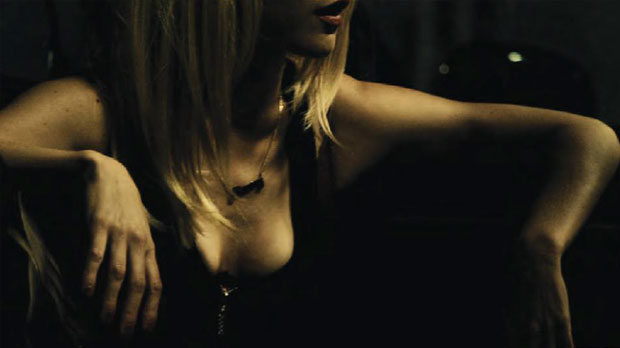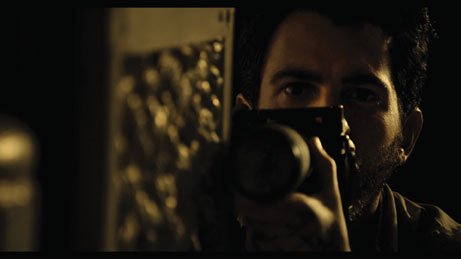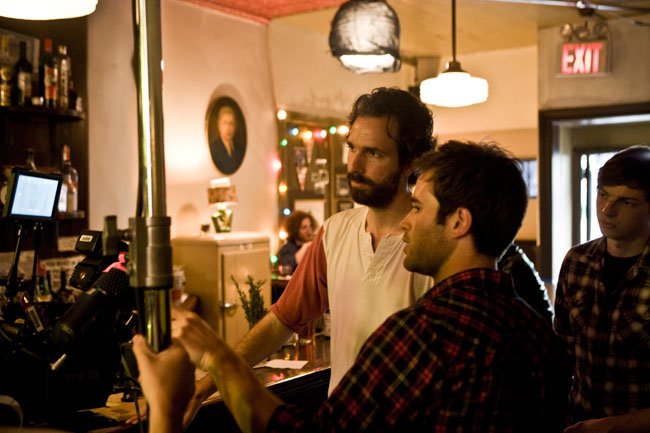 Back to selection
Back to selection
SPY CAMERA

For Dana Adam Shapiro’s eerie and erotic relationship drama Monogamy, cinematographer Doug Emmett creates a voyeuristic visual style in line with the film’s conflicted protagonist. Here D. P Eric Lin chats with Emmett about crafting the film’s unique look.

Winning the 2010 Best New York Narrative Award at the Tribeca Film Festival and a Best First Screenplay nomination at the Independent Spirit Awards, Monogamy is a well-acted and imaginatively directed film with an uncommon visual assurance. Shooting on the RED in a fluid, long-take style using a mixture of handheld and locked-off camerawork, cinematographer Doug Emmett creates a stunning look that matches the darkly voyeuristic tone of Shapiro’s story.
We asked fellow d.p. Eric Lin (The Exploding Girl) to chat with Emmett about creating the film’s look on its ultralow budget. Monogamy opens in theaters in early 2011 through Oscilloscope Laboratories.
What was it about the script that inspired you? What drew you to the story? Mainly that he was a photographer [Eric laughs]. I kind of grew up as an amateur photographer as well, and so right off the bat, I felt an intrinsic connection to this guy. Then I started reading [the script] more and more and I’m like, “Oh, I’m not really like this guy.” But it was still a cool story — I could emulate his style of photography, be a complete voyeur. He’s shooting like an undercover cop or a Peeping Tom, and to be able to replicate that in a film would be really exciting. It harkens back to films like The Conversation.
Was that your [Leica] M8 used in the film? Oh, no, it’s not. What camera we were going to use [as a prop in the film] was hard to figure out. At the last minute someone had a Leica. To be honest, it would not have been our choice. Maybe we were having clearance issues with Canon or something. Honestly, a guy who does this sort of photography wouldn’t just have a small camera with a tiny lens. He would have an array of lens and stuff. But Leicas are cool-looking cameras, and they have a history and all that. There’s definitely something sexy about the Leica versus your typical camera.
Absolutely. We ended up shooting a lot of the stills you see in the movie with a Canon 5D. I would use the Optomo 24-290mm Zoom and shoot the photography scenes, and we knew in the back of our head that our set photographer, Josh Rothstein, could then go in under our direction and capture those pivotal moments between Subgirl and her man. So some of those close-ups were staged for the camera, but mostly [they were shot during] improv. We would just let the actors do their thing, and I would just zoom in and out, picking those moments when I thought that Theo would want to be closer to the action, and the moments when he might zoom back and want to get cover and hide. I was trying to be influenced by how Subgirl was behaving, what she was looking at at any given moment. I just really wanted to put myself in the photographer’s shoes. Kind of play jazz and be experimental with it.
So you were hand-holding the Optomo? It kind of loosened up the tripod head and looked like it was handheld. We at one point discussed using the stills from the RED, but I wasn’t convinced that they would be sharp enough. We wanted to really zoom into these stills, and pick out these really pivotal things, like the ring on her finger, the tattoo, or the necklace — things that you had to be able to zoom in 500 or 600 times and still have some resolution. So that’s what we did, we would put our set photographer on a ladder, and line up the same field of view, and we would get closer and shoot it.
The movie reminded me a lot of Blow-Up. Did you and Dana talk at all about Blow-Up, another photography movie? We talked a lot about The Conversation and its voyeuristic eavesdropping feel. We talked more about the feel and less about the style of photography that we would shoot in. We also looked at a lot of The French Connection because there’s an element of stalking and being undercover and staying in pursuit of somebody else. We love that film’s style of gritty handheld, shooting in Brooklyn and Queens and Manhattan. So those were our two biggest films. I think any 1970s film with Gene Hackman is a big [hit] with us. [laughs]

What I really appreciate in the film is its nontraditional coverage, which I always find refreshing. And how did you guys develop that visual strategy? In the apartment you were handheld, but then for certain scenes you were locked off. Dana and I both decided early on that we enjoy the style of wide masters, in which the actors can do their thing uninhibited without cutting. And that’s the same for editing as well. We love the idea of two actors doing their thing without a whole lot of coverage. I feel like it’s the best way to really see and hear someone without cut, cut, cut, cut, cut. It’s more intimate. It’s raw, like theater. that DaChris was the best actor you could have ever imagined for this role.He’s an amazing guy — the master of long, improvised takes. We would shoot 20-minute handheld takes without cutting the camera, and Chris would just do his thing. Dana had some basic parameters: obviously there was a script, and there was dialogue. But Dana would let Chris loose and he would improv a lot of it. And then the two would confer. Even during the take, they would talk a little bit, then get back to acting, and then confer, and we’d still be rolling, and he’d act a little more, and my back would get sore, and he’d go even longer. It was a really fun, inspired way of working that you would never do on a big studio feature film. I started to find that my camerawork was completely influenced by what Chris was doing at that moment. If Chris was starting to get frantic, then I would get frantic. If Chris was having contemplative, quiet moments, then the camera work would settle down and get quiet again. When he moved, I moved, and it was this beautiful, intrinsic relationship between the two of us. During these long takes, I would find that all of my rules about photography would just go out the window — I was in the moment of capturing Chris. And that also goes along with the lighting. Dana and I decided that we weren’t going to have Chris hit his marks. That would be ridiculous. How can you make a film with a documentary-style feel and still ask him to hit marks for lighting? So we had to light the whole stage so he could move around and feel free in his performance. We looked at a bunch of movies before starting, and not all of them had an improv or documentary feel. We looked at films like Ratcatcher, a beautiful film, for lighting references. But it’s hard to light a movie in a really beautiful sort of way and still say to the actors, “You can go anywhere you want.” That’s just not realistic, but we tried as hard as we could to make it look pretty at the same time as to let them go anywhere. As for handheld versus sticks, I don’t see why a film can’t go back and forth. I think Lance Accord and Ellen Kuras do great jobs with that. [With their work] it’s so seamless you can’t even tell sometimes.
I’m curious, was this approach something that came to you while watching rehearsals? Or was it at the script stage? It was usually during rehearsals. Dana and I shot-listed about half the film with a rough plan for the rest, but when we started shooting we realized that was a complete waste of time. Having shot-listed doesn’t make sense when you’re just going to improv most of the scenes. So we did a walk-though during rehearsal, talked about where the camera would be, shot the master, talked about what coverage we wanted and then moved on. If we got a wide master and then an insert of a computer screen, or photos he’d taken, or if we got a close-up of his face, we would feel, “Okay, we have all the cuts that we need.” I have to hand it to Jeff Mandel, our producer, because he really gave us the freedom to do that. I think a lot of producers would freak out that we weren’t doing standard coverage. And Dana trusted his instincts. From day one, he made the movie he wanted to make. Almost exactly the way he described it.
Was this style of shooting something you had done before, or was it something totally new to you? It was definitely pretty new to me. I was used to actors saying their lines, getting their marks. Do rehearsals, do two rehearsals, and then shoot the third rehearsal, shoot the first take. We were shooting all the rehearsals, which in retrospect is tough because if you’re working out your focus marks, or lighting, you’re definitely committing to having that on film. Or, I guess I should say on a hard drive. If the editor has access to that footage and they want to use a take that you don’t think is great, they can. But there’s a certain spontaneity to a rehearsal versus an actual take. There’s something really freeing about that and I think you can see that in the final film.
Tell me about how you prepped the film. Especially with indie films, there’s a real art to prepping. We spent a month hanging out in [Dana’s] Carroll Gardens apartment, watching movies, listening to music, talking about the character, and eating constantly. I think the majority of our prep on this project was talking about this character, Theo, and barbecuing and shopping for food and cooking. Dana is 6’4”, and he’s constantly eating. Also, I owned a camera so [during prep] I was able to just pick it up and go. We’d hop into Dana’s car and drive around Brooklyn. There were three or four days of just shooting B-roll stuff and getting to know each other that way. If you’ve never shot with a director, just to go do a couple of B-roll days, roll the camera, and figure out how you like to work with each other. Talk about the feel and look of a certain lens. It’s an easy way without any pressure to get to know each other while rolling camera. By the time we got to set, I felt like we had already shot the movie in our heads. We worked kind of seamlessly once we actually got to set; we didn’t really have to discuss much.
How much were you able to scout ahead of time in terms of location? We had done a two-day scout, locked Theo’s apartment, and then I think we lost it during the first week of our shoot. We had to find a new Theo’s apartment, and the new one was so much better than the original. But we really didn’t have any daytime shoots in Theo’s apartment; it was mostly nighttime, so all the interior scenes were all lit. Which is too bad, because there were some really big, beautiful windows that I would have loved to have used the light through, but it just didn’t pan out that way.
How restrictive was the handheld approach on your lighting schemes?
I had to let go of a little bit, certainly. I didn’t have the precise control that I would’ve liked to have had. But I had an amazing gaffer, a guy named T.J. Alston. We designed [the lighting] with these bigger broader sources so that Chris could move around a lot without getting overexposed or going too dark. We would set these basic parameters, like, “Don’t get too close to this window, or don’t get too far into that corner.” Lighting wasn’t the easiest, but at least there’s still a style throughout the entire film that I feel like is consistent, which is good.
It’s an indie film, so what other limitations did you have? Schedule? Budget? I think we were operating around $200,000, so there were a lot of limitations. It was superlow. I think we had a 22-day shoot schedule, which isn’t the worst schedule for an indie film, but obviously we could have used a couple more days. That’s why the B-roll days helped. In terms of lighting, we had a pretty basic package. A couple of HMIs, a couple of Kino Flos. And on the nighttime exteriors the producers were cool enough to actually get us a generator and a couple of bigger sources, which was great. We needed to light all the exteriors. We had one big generator and a couple of smaller ones sodded around the block. I didn’t want it to get overlit — I wanted it to look very realistic and not necessarily pretty at night, either.
Were you guys shooting the MX Chip on the RED? No, the original one.
Did you stay on the Optomo the whole time, or did you use primes also? Oh, we used primes for most of the shoot because it was mostly handheld. [The Optomos are] so small and compact that they’re really hard to use on a Steadicam. I’ve since traded those away for a newer set of lens, which are great to pull focus on. They’re bigger but they don’t have that same soft, romantic quality you’d see in these older lens. There’s something nice about putting these older lens in front of the digital sensors. Completely. But we had the Optomo on most of our day exteriors, which was really helpful. It helped us move fast. On an indie budget, as many days as we did, I thought that was a real blessing.
How much of the look did you establish in the camera and how much did you find in post, in the grading? The look was pretty much built in almost from the prepro. We had talked about having a slightly more desaturated, contrasty look, a more modern look. We looked at movies like Manhattan and the way [Gordon Willis and Woody Allen] made New York City feel like a character. We thought, if we could just shoot New York in a similar style but also in a way that people have never seen it before. Kind of update that Manhattan look, and shoot new interesting off-angles. Shooting Brooklyn obviously helped because there are so many fascinating locations. There was a little bit of postgrain added, I think mainly because I thought the sensors were a little too clean. [The image] was too digital, almost plastic-looking. Dana and I both have this affinity for older, freer, Cassavetes-style cinema, and we wanted it to look not so polished and clean at the very end.
Was it always conceived as digital capture, or did you guys consider other formats at the beginning? On that budget, it was always going to be in the digital realm. I think at one point, there was talk about shooting with the [Panasonic] HVX —
Oh, wow. Yeah, I sort of freaked out. I almost gave them my camera, basically. [laughs] It goes along with being a d.p. in the indie film world, right?
You’re always fighting for the right stuff because there’s always something newer and cheaper coming out. What was the toughest scene to shoot for you, either technically or creatively? I’d have to say the 20-minute handheld scene in the hospital room. It was a really hot room, a 10’ x 10’ room, where Chris and Rashida [Jones] are having their most intense fight. Trying to capture all of that, panning back and forth, trying to remember who spoke when so that the next take I could be on them for one line and then pan over. And then remembering for the next take to do the exact opposite. Technically and physically, that was challenging. I saw my chiropractor after that. [laughs]
I think that’s what I especially appreciated about the movie — watching the camera tell the story of the film. As I was saying before, the default these days is conventional coverage and letting the editing do that. I thought it was great that you guys really did it all through the lens and the camera. Well, thanks. We tried.
